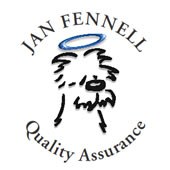
Lucy Parkes – Professional Dog Listener and Trainer. Recommended Associate of Jan Fennell International Dog Listeners.
Dog Listening is a kind, positive and holistic approach to living and working with dogs and was pioneered by Jan Fennell over twenty years ago. Seven years ago I went to Lincolnshire to train with Jan to become a Dog Listener and Trainer, and since then I’ve visited 100’s of dogs in their homes and helped them to resolve problem behaviour in their owners!
Joking aside, a very important element of Dog Listening is recognising how our everyday moods, actions and emotions impact our dogs and their behaviour, and how, by doing things a little differently, we can really help our dogs to feel happy and safe – and therefore, able to cooperate!
Dog Listening is based on studies of the wolf pack and the domestic dog, and is all about understanding the world from the dog’s perspective and communicating with him in his own language.
By using signals that correlate with those used in the wolf pack to consistently maintain and confirm the pack hierarchy, we can reassure our dogs that we are the calm and consistent Pack Leaders that they need, gain their trust, respect and cooperation and resolve problem behaviour.
The wolf pack uses ritualised behaviour to uphold and reconfirm the hierarchy with the Alpha pair (male and female wolf) at the top. Hierarchical group-living is a survival strategy, a very successful one that humans use too! The benefits are many, including safety in numbers and by deferring to the pack leaders, the rest of the pack benefit from their experience and leadership skills and the pack stays safe! Young wolves observe and learn from the Alpha wolves and may go on to become leaders of their own packs, but whilst they are ‘living under mum and dads roof’ they abide by the rules and these powerful predators are able to live together successfully!
This ritualised behaviour is particularly visible at four important times of pack life –
1. Food – when the pack eats. The Alpha wolves eat first. Underlining primacy and ensuring that they get the best bits, to keep them in the best condition, to keep doing the important and stressful job of leader.
2. The Hunt – heading out into the wider-world (we call this the walk).The Alpha wolf decides when and where, leading the hunt and directing the kill. The rest of the pack provide back-up and support.
3. Times of danger – the low-ranking, subordinate wolves keep an eye – and a nose – out for danger, and alert the Alpha wolves if there is a threat. The Alpha wolves will decide what to do about it, choosing from one of three options – flight, freeze or fight.
4. General status – This is how they relate to each other in general and is never more evident than when the pack reunites after a separation. At this time, the sub-ordinate wolves are especially respectful of the Alpha wolves’ personal space.
You’ll notice that these key times of pack life occur in our lives with our dogs too and that they are the areas where we can experience problem behaviour. Pulling on the lead, jumping up at people, excessive barking, fussy eaters, poor recall, through to the more extreme problems of aggression towards other dogs and people, destruction, obsessive/compulsive patterns of behaviour and separation anxiety, can all be examples of a stressed dog who is confused about leadership.
Dog Listening is a kind, positive and holistic approach to living and working with dogs and there is absolutely no place for the use of force – whether literal, verbal or psychological! The use of force is counter-productive. When it appears to have worked, it has usually shifted the problem to another area. The regular use of force, even raising your voice, can cause anxiety and stress and lead to behavioural and health problems.
“Force is all-conquering, but it’s victories are short-lived” – Abraham Lincoln
Through leading by example, we can inspire our dogs to calmly cooperate with us, in the house and garden first . . . and then the sky’s the limit! We can head out into the world knowing that our dogs are looking to, and trusting us, and that we can safely and calmly manage the multitude of challenges that the modern dog and owner can face, when she/he leaves the safety of the home.
I would like to share with you examples of the wonderful people and dogs that I have had the privilege of working with over the years. I also hope to share with you, how, through understanding, compassion and patience, we can resolve almost all problem behaviour in our dogs – without the use of force, gadgets or gizmos – and create with them the calm, peaceful and harmonious lives together, that we all desire.













